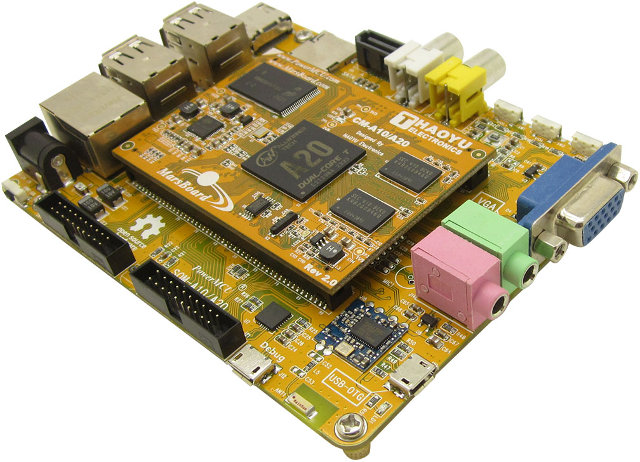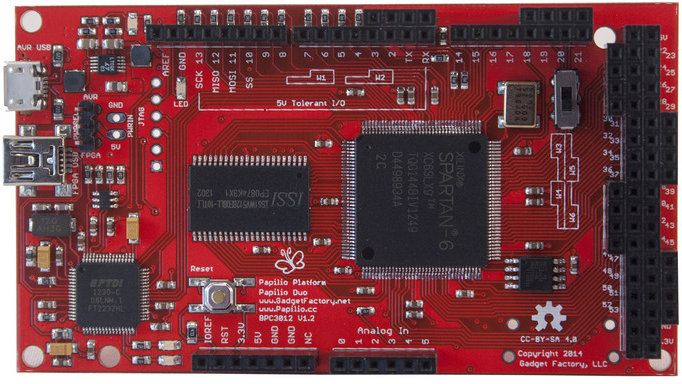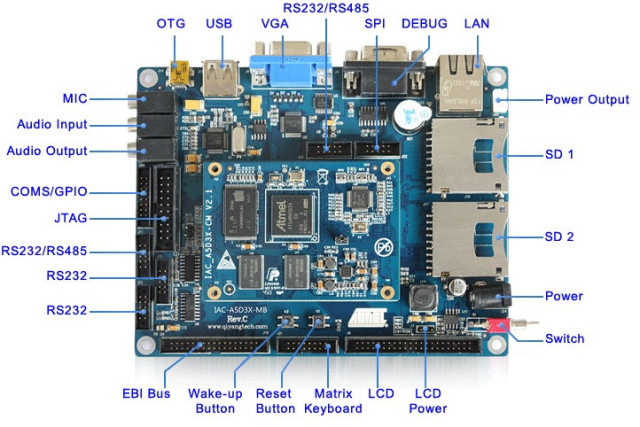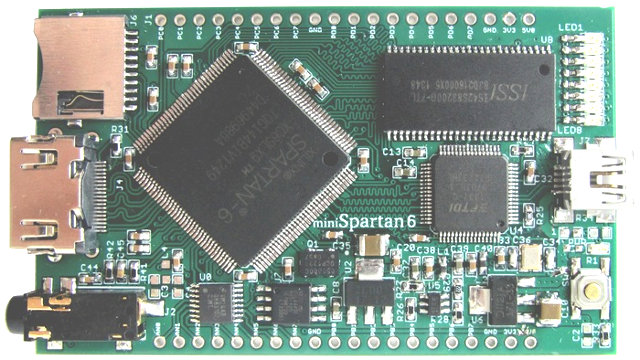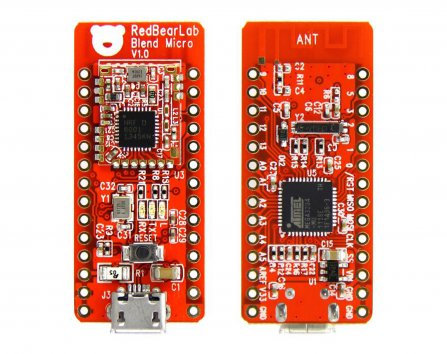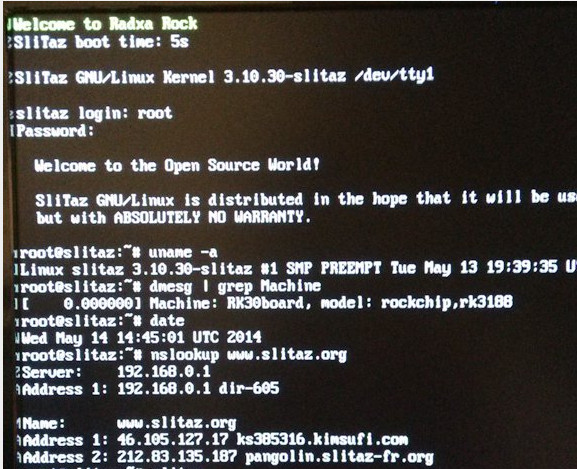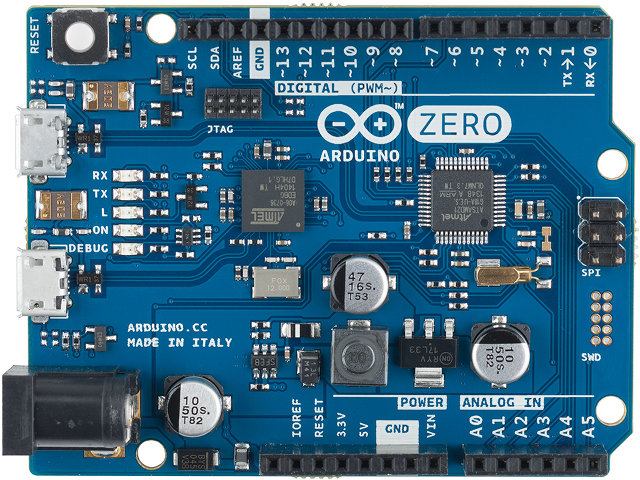MarsBoard, a development board based by AllWinner A10 was released last year, soon followed by MarsBoard A20 with a dual core Cortex A7 AllWinner A20 processor. That board is now called the “Old MarsBoard A20” and is replaced by the “New MarsBoard A20” that features a baseboard + computer-on-module design, increases the NAND flash capacity to 8 GB flash, and supports 1GB RAM by default, with an option for 2 GB RAM. Let’s check the specifications of this new development board: SoC – AllWinner A20 ARM Cortex A7 dual core processor @ 1GHz + Mali-400 GPU System Memory – 1GB DDR3 @ 480 MHz by default, up to 2GB DDR3 Storage – 8GB NAND Flash, SATA II interface, and micro SD slot Video I/O HDMI up to 1080p60 VGA Composite output TV-IN (composite IN) LCD connectors for RGB and LVDS interfaces, capacitive touch support Audio I/O – HDMI, Line In/Out, Microphone […]
$88 Papilio DUO Arduino Compatible Board with a Xilinx FPGA Let You to Draw your Own Circuits
In a concept similar to Arduissimo, Papilio DUO is an Arduino compatible board with a Xilinx Spartan-6 FPGA, but it adds a real Atmel AVR MCU, and instead of going the Indiegogo route, the project has launched on Kickstarter, and already reached its $30,000 funding target with 13 days to go. Instead of writing VHDL code, a drag and drop graphical tool called DesignLab will help you build your own circuits more easily. Let’s go through the hardware specifications first: FPGA – Xilinx Spartan 6 LX9 FPGA System Memory – 512KB or 2MB ISSI IS61WV5128 SRAM Storage – 64Mbit Macronix MX25L6445 SPI Flash MCU – Atmel AVR ATmega32U4 (Same as Arduino Leonardo) USB – 1x micro USB port connected to the Atmel MCU, 1x mini USB port connect to the FPGA I/Os 54 I/O pins available via Arduino Mega headers 0-16 Digital Pins connected to FPGA and ATmega32U4 JTAG Power – High […]
Qiyang Technology ARM Development Boards Based on Atmel SAMA5D3, TI Sitara AM335x and Freescale i.MX6 SoCs
Hangzhou Qiyang Technology (杭州启扬智能科技有限公司) is a company based in Hangzhou, China, that provides embedded hardware solutions such as low power development boards and computer-on-modules. I’ve recently come across the company, and they have boards for various ARM based SoCs, but I’ve received details about three of their latest industrial development boards powered by Atmel SAMA5D3 Cortex A5 processor, Texas Instruments Sitara AM335x Cortex A8 SoC, and Freescale i.MX6 single and multi-core ARM Cortex A9 SoCs. Let’s have a look. Qiyang QY-A5D3XEK – Atmel SAMA5D3 Development Board The development kit is comprised of a base board (IAC-A5D3X-MB) and a computer-on-module (ICA-A5D3X_CM) with the following hardware specifications: Processor – Atmel SAMA5D3 ARM Cortex A5 @ 536 MHz (Either SAMA5D31, SAMA5D33, SAMA5D34 or SAMA5D35) System Memory – 256 MB DDR2 @ 333 MHz Storage – 256MB NAND flash + 2MB dataflash on CoM, 2x SD card slot on baseboard Video Output – VGA, […]
$69 miniSpartan6+ Board with Xilinx Spartan 6 FPGA Features an HDMI Port (Crowdfunding)
I’ve already featured sub-$100 Xilinx Spartan 6 boards in this blog such as The Mojo and Arduissimo. There’s now another with Scarab Hardware‘s miniSpartan6+ which also includes an HDMI port, and is currently available for $69 on Kickstarter. This board could be used as a logic analyzer, a multimedia player, a game console emulator, an Arduino emulator, a stereo vision camera, and more. miniSpartan6+ specifications: FPGA- Xilinx Spartan6 LX9 System Memory – 32 MB SDRAM Storage – 64Mbit SPI Flash + micro SD card Video Output – HDMI Audio Output – Stereo audio output jack using 1-bit sigma-delta DAC USB – Micro USB OTG port Debugging – On-board USB JTAG programmer I/Os via breadboard friendly through holes 8-channel ADC running at 1 MSPS with 8 bit resolution. 24 Digital I/O pins. Misc – 8 LEDs. Dimensions – 4.57 x 7.62 cm Programming can be done with the company’s Scarab IDE, […]
Blend Micro Arduino Board Integrates Bluetooth 4.0 Low Energy Connectivity for 25 Euros
RedBearLab’s Blend Micro is an Arduino compatible board with Bluetooth 4.0 Low Enery (aka Bluetooth Smart) connectivity, that’s part of Arduino-at-heart, a partner program initiated by the developers of Arduino boards. It has been made to help design low power Internet-Of-Things (IoT) projects quickly and easily. Blend Micro technical specifications: MCU – Atmel ATmega32u4 @ 8 MHz with 32KB flash (4KB used by bootloader), 2.5 KB SRAM, and 1KB EEPROM. Connectivity – Bluetooth 4.0 Low Energy via Nordic nRF8001 chip USB – 1x micro USB port I/Os: Serial (Tx/Rx) I2C, SPI PWM U to 16 Digital I/Os Up to 6 Analog inputs Operating Voltage – 3.3V Input Voltage – 5V (USB), and 3.3-12V (VIN) Power Consumption – 2mA (average – using Interrupt mode) Dimensions – 43.6 x 18.4 x 4.3mm Weight – 4g The specs are very similar to BLEDuino, except it’s slightly smaller. Blend Micro can communicate with BLE […]
Linaro 14.05 Released with Linux Kernel 3.15, Android 4.4.2, and Ubuntu Trusty
Linaro 14.05 has been released with Linux Kernel 3.15-rc5 (baseline), Linux Kernel 3.10.40 (LSK), Android 4.4.2, and Ubuntu has been switched from Saucy to Trusty. More work has been done on big.LITTLE processing and ARMv8 support with notably completing bootstrapping with Debian 64-bit. New hardware platform have started to pop-up such as TI J6-Vayu which must be an evaluation board for Texas Instruments Jacinto 6 dual core Cortex A15 SoC for automotive application, as well as IFC6410, a Snapdragon 600 development board which got a Ubuntu LEB image. This month also marks the first release of Linaro GCC 4.9 toolchain. Here are the highlights of this release: Linux Linaro 3.15-rc5-2014.05 new Android topic (linaro-android-3.15-experimental) uses the resent AOSP code base GATOR version 5.18 (same version as in 2014.04) uprobes topic removed as all patches have been accepted into mainline updated big-LITTLE-pmu topic from ARM LT updated basic Capri board support […]
Ubuntu 14.04 and Slitaz on Radxa Rock
Various Android and Linux images are available on Radxa Rock download page, but if you’d like to get newer images or other options, two developers have provided binaries and posted instructions to get Ubuntu 14.04 and Slitaz operating systems, the later currently booting with Linux kernel 3.10. Naoki FUKAUMI has published a miniroot how-to install a Ubuntu 14.04 Core (minimal headless installation) on Radxa Rock and Radxa Rock Lite. Installation should be relatively easy as he provide the update.img for both board so your can use the usual method in Windows (RkBatchTool) or upgrade_tool in Linux. If you don’t have serial console, you’ll have need to flash the parameter file requiring RkAndroidTool in Windows, and the same upgrade_tool in Linux. If once the installation and configuration is complete, you want a desktop environment,you can always run “apt-get install lubuntu-desktop” to install LXDE. SliTaz is a lightweight Linux distribution. I previously […]
Arduino Unveils Arduino Zero Board Featuring Atmel SAMD21 Cortex M0+ MCU
Arduino and Atmel have jointly announced the latest addition to the Arduino family with Arduino Zero, a development board based on Atmel SAMD21 ARM Cortex M0+ MCU with the same form factor and headers as Arduino UNO / Leonardo. Arduino Zero specifications: Microcontroller – Atmel ATSAMD21G18 32-bit ARM Cortex M0+ MCU @ 48 MHz with 32 KB SRAM, 256 KB flash, up to 16KB EEPROM (By emulation). 48-pin LQFP package. Digital I/O Pins – 14, with 12 PWM and UART Analog Input Pins – 6, including 5 12bits ADC channels and one 10 bits DAC DC Current per I/O Pin – 7 mA USB – 2x micro USB ports Debugging – USB via Atmel’s Embedded Debugger (EDBG) on-board debugger, and JTAG Misc – reset button, 5 LEDs (Tx, Rx, L, On, Debug) Operating Voltage – 3.3V That’s about all we know for now, as tools support (Arduino IDE?), availability and […]


